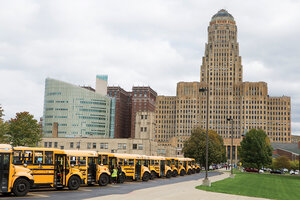Why desegregation matters
Separateness can be beautiful, expressed in distinct cultures, traditions, and nations. But when the Supreme Court declared in 1954 that “Separate educational facilities are inherently unequal,” it touched on a truth.

School buses line up outside Waterfront Elementary School in Buffalo, N.Y. City Hall is in the background.
Melanie Stetson Freeman/Staff
For the 13 years she went to public school in Buffalo, N.Y., Monitor staff writer Stacy Teicher Khadaroo got a different picture of her hometown.
To many of the adults around her, Buffalo was one of the more segregated cities in the United States. As in many other cities, there was a “wrong side of the tracks” – places where some residents wouldn’t go, places where others couldn’t. But to Stacy, there were just friends, some white, some black, some from one side of town, some from the other. Her Buffalo was a product of the city’s pioneering efforts to desegregate its schools.
Today, those schools have resegregated, and the story of Stacy’s hometown is in many ways the story of the nation. From blue/red to black/white, the US is struggling to come to terms with segregation in various forms. School segregation is just a symptom of the broader condition. But to understand that broader condition, it’s a good place to start.
School desegregation did not come easily. It took the Supreme Court’s landmark Brown v. Board of Education ruling and the deployment of the 101st Airborne Division in Little Rock, Ark., for a start. Then it took busing, redistricting, and civil rights laws to reach a point – somewhere in the 1990s – when US public schools could say they had made significant headway toward ending segregation.
Then it crumbled.
Why? The commitment to it waned. White flight kept America segregated, and many of the guardrails put in place to maintain school desegregation were allowed to atrophy or were actively targeted in lawsuits. Desegregation was seen as too hard or not important enough. Busing was controversial. Redistricting was complicated. Civil rights laws impinged on local authority.
Buffalo raises the possibility that desegregation, if not enforced, doesn’t happen. School resegregation, after all, is largely a product of the fact that Americans live in segregated communities, the result of sorting themselves along economic and racial lines. Recent voting patterns have shown that Americans are increasingly segregating ideologically, too.
Segregation matters because it limits opportunity. In their purest form, economies take no account of race, creed, or sex. Economies want opportunity to spread widely. As that happens, growth occurs. That happened nationwide, Stacy notes. “African-Americans who attended integrated schools in the US in the 1960s, ’70s, and ’80s had better outcomes than those who did not, and the benefits persisted among their children and grandchildren.” Among the benefits: higher educational attainment, increased earnings by one-third, and large reductions in the incidence of poverty and incarceration.
Segregation also matters because it influences how we see our world. Separateness can be beautiful, expressed in distinct cultures, traditions, and nations. But when the Supreme Court declared in 1954 that “Separate educational facilities are inherently unequal,” it touched on a truth. The struggle to continually find a new and deeper sense of unity is never easy, but the reward, history repeatedly shows, is expanded wealth and well-being for all.

